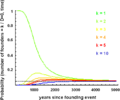File:Time to the MRCA for mtDNA and Y-STR Types for the Mlabri and the Other Hill Tribes.png
Time_to_the_MRCA_for_mtDNA_and_Y-STR_Types_for_the_Mlabri_and_the_Other_Hill_Tribes.png (661 × 255 pixels, file size: 10 KB, MIME type: image/png)
Captions
Captions
| DescriptionTime to the MRCA for mtDNA and Y-STR Types for the Mlabri and the Other Hill Tribes.png |
English: Time to the Most Recent Common Ancestor for mtDNA and Y-STR Types for the Mlabri and the Other Hill Tribes
Posterior probability distribution of the time back to the most recent common ancestor for the mtDNA (A) and Y-STR haplotype (B) data for the Mlabri and six other hill tribes (Akha, Lahu, White Karen, Red Karen, CR Lisu [from near Chiang Rai], and MHS Lisu [from near Mae Hong Son]). The estimates of coalescence time for the Mlabri show a sharp peak, with a median time of 770 y (approximate 95% credible interval 250–4,270 y) for the mtDNA sequences and 490 y (approximate 95% credible interval 170–1,290 y) for the Y-STR haplotypes. Both the mtDNA and the Y-STR data indicate that the Mlabri underwent a substantial reduction in population size about 500–800 y ago (and not more than about 1,300 y ago, if the mtDNA and Y-chromosome data reflect the same event). There are two possible scenarios: (1) a bottleneck, in which the Mlabri were reduced from a formerly large population to a much smaller population size, which then increased to the current level of about 300 individuals; or (2) a founder event, in which the Mlabri began as a very small number of individuals, became isolated, and then increased over time to their present size. Similar reductions in genetic diversity are predicted under either scenario, so the genetic data cannot distinguish between these. |
| Date | Published: February 22, 2005 |
| Source | Oota H, Pakendorf B, Weiss G, von Haeseler A, Pookajorn S, Settheetham-Ishida W, et al. (2005) Recent Origin and Cultural Reversion of a Hunter–Gatherer Group. PLoS Biol 3(3): e71. doi:10.1371/journal.pbio.0030071 http://journals.plos.org/plosbiology/article?id=10.1371/journal.pbio.0030071 |
| Author | Hiroki Oota , Brigitte Pakendorf , Gunter Weiss, Arndt von Haeseler, Surin Pookajorn, Wannapa Settheetham-Ishida, Danai Tiwawech, Takafumi Ishida, Mark Stoneking |
| Permission (Reusing this file) |
This is an open-access article distributed under the terms of the Creative Commons Attribution License |
| Other versions |
|
|
This file is licensed under the Creative Commons Attribution 2.5 Generic license.
|
This file was published in a Public Library of Science journal. Their website states that the content of all PLOS journals is published under the Creative Commons Attribution 4.0 license (or its previous version depending on the publication date), unless indicated otherwise.
|
File history
Click on a date/time to view the file as it appeared at that time.
| Date/Time | Thumbnail | Dimensions | User | Comment | |
|---|---|---|---|---|---|
| current | 13:55, 28 January 2017 | 661 × 255 (10 KB) | Was a bee (talk | contribs) | {{Information |Description={{en|1=Time to the Most Recent Common Ancestor for mtDNA and Y-STR Types for the Mlabri and the Other Hill Tribes Posterior probability distribution of the time back to the most recent common ancestor for the mtDNA (A) and Y-... |
You cannot overwrite this file.
File usage on Commons
The following 2 pages use this file:
Metadata
This file contains additional information such as Exif metadata which may have been added by the digital camera, scanner, or software program used to create or digitize it. If the file has been modified from its original state, some details such as the timestamp may not fully reflect those of the original file. The timestamp is only as accurate as the clock in the camera, and it may be completely wrong.
| Horizontal resolution | 141 dpc |
|---|---|
| Vertical resolution | 141 dpc |



